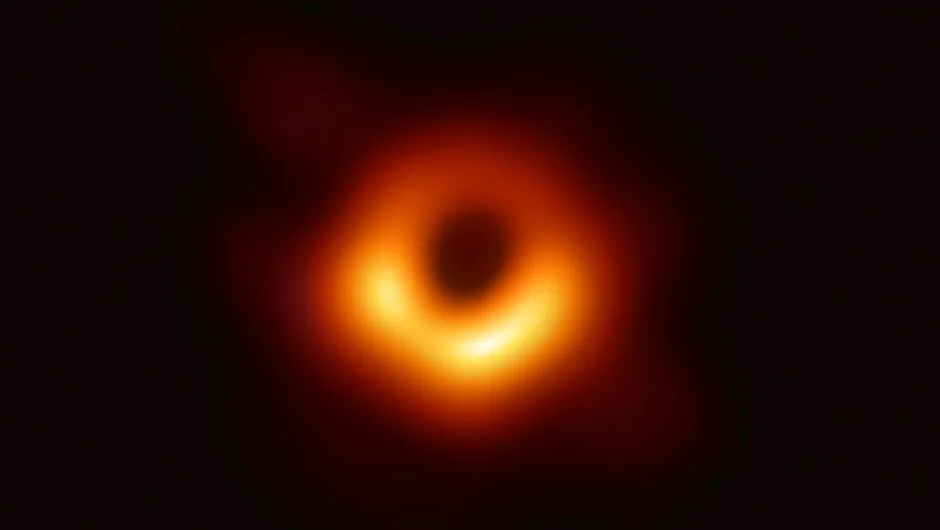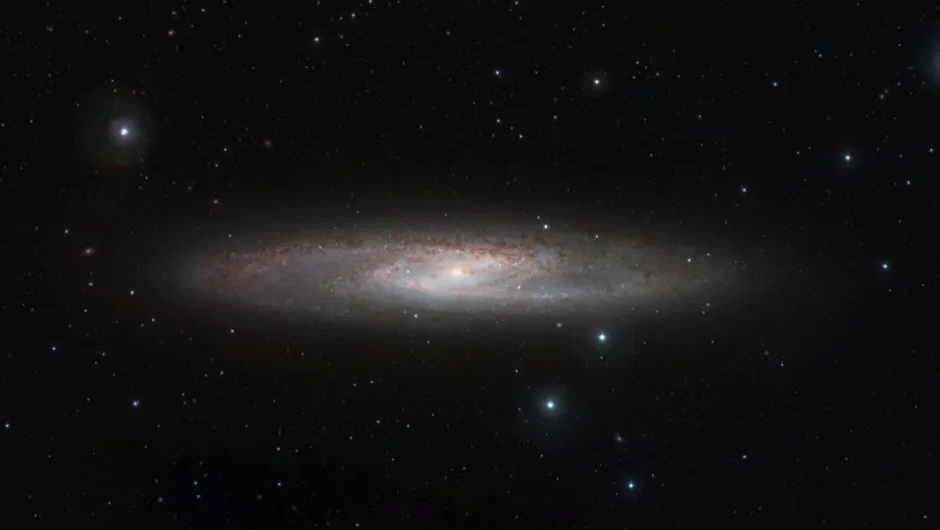What does a black hole look like?

Thanks to the Event Horizon Telescope (EHT) Collaboration, we now know exactly what a black hole looks like after they released the first ever picture of one. This ghostly image shows the supermassive black hole at the centre of Messier M87, and was taken by a network of eight different telescopes pointed towards the galaxy some 55 million light-years from Earth.
As its gravitational pull is so great, no light is able to escape, so the dark centre of the image is actually the black hole's shadow, and the ring of orange and yellow is a swirling mass of superheated dust and gas around the event horizon. This ring is known as the accretion disk, and it is the radiation emitted from matter billions of degrees in temperature that the EHT was able to picture.
How big could a black hole get?
Asked by: Vanessa Taylor, Nottingham
There is no theoretical upper limit to the mass of a black hole. However, astronomers have noted that the ultra-massive black holes (UMBHs) found in the cores of some galaxies never seem to exceed about 10 billion solar masses. This is exactly what we’d expect from the rate at which we know black holes grow, given the time that’s elapsed since the Big Bang.
Furthermore, recent studies suggest that UMBHs cannot physically grow much beyond this anyway, since they would then begin to disrupt the accretion discs that feed them, choking the source of new material.
- Dr Alastair Gunn
Who really discovered black holes?
While their enigmatic name was first coined in 1967, the idea of objects whose gravity is so intense not even light can escape them is far older. In 1783, an English cleric and amateur scientist named John Michell showed that Newton’s law of gravity suggested such objects could exist. But Michell went further, suggesting that despite being invisible, such objects might reveal themselves if they happened to have a star in orbit about them.

He proved to be amazingly prescient in both respects. During the 1930s, theorists using Einstein’s more sophisticated theory of gravity, known as General Relativity, showed that sufficiently massive stars could collapse under their own gravity at the end of their life, and turn into black holes (ironically, Einstein himself never accepted that such strange objects could really exist).
Michell’s second claim was confirmed in the early 1970s. British astronomers Louise Webster and Paul Murdin at the Royal Greenwich Observatory and Thomas Bolton, a student at the University of Toronto, independently announced the discovery of a massive but invisible object in orbit around a blue star over 6,000 light-years away. The object, an intense X-ray source codenamed Cygnus X-1, is now regarded as the first black hole to be identified.
- Robert Matthews
Do black holes collapse?
Asked by: Patricia Rodrigues, King’s Lynn
The Schwarzschild radius (event horizon) of a black hole is sometimes thought of as the black hole’s ‘size’. It is proportional to mass, which means that more massive black holes have bigger Schwarzschild radii. Left alone, black holes lose mass due to ‘Hawking radiation’, so that their event horizons are slowly shrinking.
A typical black hole would take many billions of times the age of the Universe to completely ‘evaporate’ and disappear. But, the interior of the black hole, or its ‘singularity’ (the point at which all the black hole’s matter is concentrated) has already reached the limit of its density and cannot ‘collapse’ any further.
- Dr Alastair Gunn
Why don’t black holes ignite?
Asked by: Ray Sudbury, Mansfield
Physics cannot yet describe the kind of material that ordinary matter becomes once it is inside a black hole’s event horizon. However, one thing is certain; matter does not survive in a form containing atoms. The usual particles of ordinary matter, electrons, protons and neutrons, have all combined into other particles or broken apart completely into quarks (or ‘preons’). They may have been squeezed into a mere quantum probability, or not be ‘matter’ at all! Given that black holes are not made of regular matter, there is no process (nuclear fusion for example) by which they can ‘ignite’.
- Dr Alastair Gunn
Read more:
- The nine most mysterious objects in the Universe
- Wormholes: Could we travel through a black hole into another galaxy?
Why do the centres of galaxies contain black holes?
Asked by: Adam King, Huddersfield
Since the 1960s, astronomers have uncovered evidence that most galaxies contain so-called supermassive black holes at their cores. With masses between a million and a billion times that of the Sun, these leviathans first revealed their presence in so-called quasars – distant galaxies with cores so luminous the only plausible source of power is the intense gravity of black holes devouring matter. Since then, studies of stellar orbits have shown that even relatively tranquil galaxies like our own Milky Way harbour hefty black holes.
Their origin remains a mystery, however. They may have been created by the gravitational collapse of giant gas clouds from which galaxies were formed, or from the merger of many smaller black holes over time. Another possibility is that one simply grew over billions of years by steadily devouring orbiting stars.
- Robert Matthews
Does time feel slow in a black hole?
Asked by: Reece Shanks, age 9, Scotland

No, because you have no way of ‘feeling’ the passage of time.
It is true that large gravitational forces (such as when you approach a black hole) slow down time, but you can only be aware of this by comparing your experiences with someone far away from the black hole. You will see a distant friend ‘sped up’ rather than feel yourself ‘slowed down’. They will see you ‘slowed down’ rather than feel themselves ‘sped up’.
The closer you approach the black hole’s ‘event horizon’ the more sped up you see your friend. But for you, time would ‘feel’ just as it does to you right now.
- Dr Alastair Gunn
Is a black hole a hole?
Asked by: Christine Bingham, Nottinghamshire
No, a black hole is not really a hole at all. A black hole is an object just like any other, except that it is extremely dense. This gives it such a high gravitational field that nothing, not even light, can escape. Because no light escapes a black hole, it is invisible – or ‘black’ – although they can be detected by their effect on the material around them. The term ‘hole’ was used because whatever falls ‘into’ a black hole is trapped forever.
Science fiction often depicts black holes as portals between different parts of the Universe, different times or different universes altogether. This may be why it is often misconstrued that black holes are ‘holes’ in space-time. This concept isn’t entirely fictional, however.
In 1935, Albert Einstein and Nathan Rosen proposed ‘wormholes’ through space-time, which could provide a means of traversing large distances instantaneously. But a naturally occurring black hole doesn’t form a wormhole by default. In fact, there are doubts they could occur naturally at all, that they would remain stable for more than a fraction of a second or that they would be anything bigger than vanishingly small.
- Dr Alastair Gunn
Do black holes rotate?
Asked by: Joe Stoloff, Rochdale
Yes. All astronomical objects, including black holes, are formed by gravity pulling matter together. If a cosmic body originates from anything that had even the tiniest amount of rotational motion originally, then this spin rate will become greatly enhanced as the object collapses.
In a turbulent and angular momentum-rich Universe like ours, this means everything from dust particles to black holes will have some degree of rotation. Certain objects have observed properties that seem to be a direct result of the rotation of black holes.
- Dr Alastair Gunn
Could black holes be portals to other universes?
Asked by: Stuart Laws, by email

Some physicists have attempted to combine quantum mechanics with the General Theory of Relativity and concluded that black holes may not contain a ‘singularity’, the point at which density becomes infinite. This would open up the possibility that black holes are shortcuts to other universes. Actual tunnels through space-time, called ‘wormholes’, may be a better bet for traversing between universes. But although they’re predicted by Einstein’s theories, no wormholes have yet been discovered, and there are doubts that they could occur naturally at all.
- Dr Alastair Gunn
Are black holes always found at the centre of galaxies?
Asked by: Michael Thorne, Havant
Although it seems very likely that most spiral galaxies (and possibly all types of galaxies) contain a black hole, these are not the only places where these gravitational beasts reside.
By their very nature, black holes are not directly observable, and astronomers rely on their effects on the environment to detect them. The disc of material orbiting a black hole can become extremely hot and emit huge quantities of radiation (mainly X-rays), which may be detected by telescopes. Many of the Universe’s more energetic phenomena have therefore been attributed to the accretion of matter by black holes. These include discs that eject powerful beams of X-rays.
Astronomers have also discovered isolated, stellar-mass black holes adrift among the stars in our Milky Way. These have been found indirectly by measuring how their extreme gravity bends the light of a more distant star behind them.
- Dr Alastair Gunn
Do black holes really fall asleep?
Asked by: Tim Reynolds, Canterbury

Supermassive black holes reside deep in the cores of galaxies and create huge amounts of X-ray emissions as they continually devour material. Such objects are thought to hide in the heart of all galaxies. But recently, astronomers were surprised to find that one such black hole, in the Sculptor Galaxy (NGC 253) (pictured), appears to have fallen asleep!
Observations by NASA’s NuSTAR spacecraft have failed to detect X-ray emission from NGC 253, whereas observations a decade ago by the Chandra X-ray Observatory showed telltale signs of the black hole feeding. Astronomers are not yet clear as to whether the black hole has become dormant or whether the Chandra observations were from a different source of X-rays.
Researchers are now hoping the black hole will wake from its slumber, and they’ll be ready to catch it if it does!
- Dr Alastair Gunn
Do all spiral galaxies have black holes at their centre?
Asked by: Roger Britton, Redruth
Although not certain, it seems very likely that most (if not all) spiral galaxies contain a supermassive black hole and sometimes more than one. That uncertainty exists for two reasons. First, we can’t physically examine every spiral galaxy in the Universe to be completely convinced of that fact. Second, theory tells us that it isn’t necessary for galaxies to contain central black holes – they will still hold together as galaxies without them.
For many galaxies, however, black holes (or rather their effects on their environments) are clearly observed in the turbulent core regions and the dynamics of their stars often indicate the presence of extremely massive objects.
There is also very strong evidence that black holes may be crucially important, perhaps even required, in the formation of galaxies in the early Universe. This would imply that indeed all types of galaxies (including spirals) contain a gravitational beast at their heart.
- Dr Alastair Gunn
Listen to the Science Focus Podcast:
- What asteroids can tell us about our Solar System - Natalie Starkey
- Is there anybody out there? - Mike Garrett
Are black holes hot or cold?
Asked by: Martin Hearne, Chorley
Black holes are freezing cold on the inside, but incredibly hot just outside. The internal temperature of a black hole with the mass of our Sun is around one-millionth of a degree above absolute zero.
Just outside the hole, however, the material being pulled into the hole’s gravity well is accelerated to near the speed of light. The molecules of the material collide with such vigour that it is heated up to a temperature of hundreds of millions of degrees. When astronomers study black holes, this is the material that they see.
The radiation from the material masks the tiny amount of radiation escaping from the hole itself, and so what the astronomers observe is the very hot outside environment, rather than the freezing cold environment inside.
- Len Fisher
Is it possible for a planet to be in orbit around a black hole?
Asked by: Ryan Sullivan, Hertfordshire
There’s no fundamental reason why not: despite their reputation for devouring anything that goes into them, black holes are really just another source of gravity – like a star. As such, they’ll cheerfully allow anything to orbit them if it travels fast enough. For a black hole with the same mass as our Sun, the required speed is the same as that needed to orbit at the same distance from our parent star.
Whether any planets really do orbit black holes is a different matter, however. That’s because black holes of solar mass are usually the remnants of huge stars that run out of nuclear fuel and detonate in a supernova explosion. The chances of any planet remaining intact through such a cataclysmic event seem pretty slim.
That said, in 1992 the very first planets ever discovered beyond our own solar system were found orbiting a pulsar, another form of supernova remnant. Quite how they survived the destruction of their parent star is something of a mystery. One possibility is that they were formed after the supernova, from the debris created by the explosion. So despite the odds, it may just be possible that there are black holes out there with planets orbiting them.
- Robert Matthews
Why can gravity escape a black hole but not light?
Asked by: Oisin Peavoy, Dublin
To escape from within a black hole requires faster than light speeds, but according to Einstein’s theory of gravity, General Relativity, gravity is the distortion of space and time caused by the presence of mass. As such, gravity doesn’t escape from within the interior of the black hole: it’s simply caused by the hole’s presence.
If black holes collide, however, the space-time surrounding them responds by producing ripples known as gravitational waves; but again they aren’t ‘escaping’ from within the black holes.
- Robert Matthews
Subscribe to BBC Science Focus Magazine for fascinating new Q&As every month and follow @sciencefocusQA on Twitter for your daily dose of fun facts.